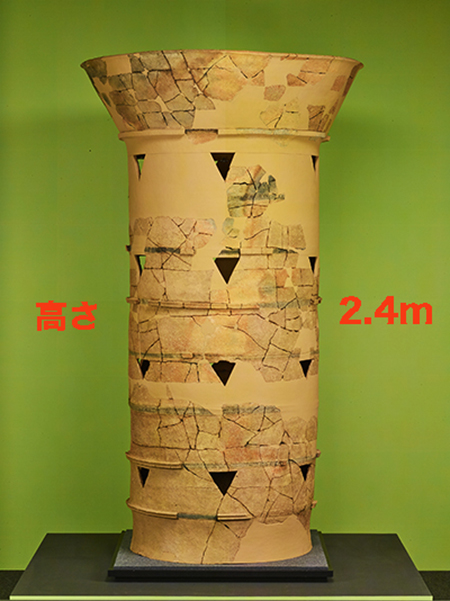


飛鳥・明日香の地に隣接する各地にはロマンを感じるスポットが多数。
明日香から直線距離で5-6km隣接の桜井市にはこの古墳がある。
っていうか、古墳はこの地域にありすぎるほどある。
日本の王権がこの地を離れざるを得なかった大きな理由のひとつに
有力者の古墳が多くなりすぎて有効利用可能な土地がなくなったことがあっただろう。
それと並行して「火葬」の習慣が日本に根付くようになる。
最初の火葬の記録は700年の僧・道昭で仏教式の葬送の創始とされている。
仏教の本格的導入と並行して古墳造営が下火になっていく。
飛鳥京最後の天武・持統の夫婦の天皇はふたりでひとつの古墳に収まっている。
持統期に火葬の習慣が一種のブームになっていて
持統自身も火葬に付されて天武の葬られた古墳にいっしょに入った。
まぁ仲の良かった夫婦だったのだろうかと微笑ましいと同時に
このような事情が絡み合った事態のように思える。
一方でこのメスリ山古墳は以下のような概要。3番目の写真は空撮写真。
〜墳丘長224メートル(250メートルとする説も)。後円部は3段築成で
径128メートル・高さ19メートル。各段に円筒埴輪列が巡り斜面には人頭大の葺石。
円筒埴輪は後円部の三段と方形壇の墳頂部に密集して二列、
また墳頂部では二列の埴輪の間隔をとっている。
後円部頂の竹垣状埴輪の囲いは長辺約11.3メートル短辺約4.8メートル。
想定高さ1メートルを下らない長方形の壇。直径1メートルもの円筒埴輪は
方形埴輪列の最内側の角や辺を等分する位置に立っている。
器台型埴輪は高さ2.4メートル径1.3メートルで日本最大。
規模・埋葬品とも大王墓級だが記紀や『延喜式』などに陵墓としての伝承がない。
墳丘規模・埴輪の大きさ・埋葬施設・副葬品収納施設・遺物などを考え合わせると、
本古墳は絶大な権勢を誇った首長の墳墓であると考えられる〜以上Wiki記述。
その規模感と造営への執念を考え合わせ、しかも埴輪の列柱という
装飾感覚まで含めて考えると、なかなか理解しがたいものがある。
埴輪の巨大さには展示で目にして驚かされた。
墓なのでその被葬者の周りの人々、権力継承者たちが被葬者から
受け継いだ権力の正統性の証として造営しただろうと推測はできる。
とくに埴輪の列柱的配置デザインにはメッセージ性が強かったのだろう。
エジプトのスフィンクスも見るものにその建築動機を謎かけしていると
伝承されているけれど、日本の古墳、埴輪群にも
同じような体験感があるのだと思う。よくわからないことで
長く人々を惹き付け続けている、そのこと自体が目的なのかも知れない。
古代人からの「建築デザイン」の問いかけのように思えてならない。・・・
English version⬇
Ancient architectural design “Mesriyama Tumulus” Exploring Asuka, Nara – 12
The construction of a small hill by civil engineering work and the elaboration of its form send a message like a riddle with thatched stones and haniwa clay figurines. Architectural semantics. …
There are many romantic spots in the areas adjacent to Asuka and Asuka.
Sakurai City, 5-6 km from Asuka in a straight line, is home to these burial mounds.
In fact, there are too many kofun tombs in this area.
One of the main reasons why the Japanese kings were forced to leave this area was
One of the main reasons why the Japanese kings had to leave the area was that there were too many burial mounds of influential people, and there was no more land available for effective use.
In parallel, the custom of “cremation” took root in Japan.
The first record of cremation is attributed to the monk Dosho in 700, who is considered the originator of Buddhist-style funerals.In parallel with the full-fledged introduction of Buddhism, the construction of kofun (burial mounds) declined.
The last two emperors of Asuka-kyo, the couple Temmu and Jito, were both buried in one burial mound.
During the Mochito period, the practice of cremation became a kind of boom.
Mochito himself was cremated and placed in the burial mound with Temmu.
It is a very funny story that they must have been a close married couple.
At the same time, the situation seems to have been intertwined with such circumstances.
The third photo is an aerial view.
〜The length of the mound is 224 meters (some say 250 meters). The rear part is built in three stages
128 meters in diameter and 19 meters high. Each tier is surrounded by rows of cylindrical haniwa terra-cotta tombs, and on the slope is a thatched stone the size of a human head.
There are two rows of cylindrical haniwa densely packed at the top of the three levels of the rear circle and square platform.
The top of the mound is spaced between two rows of haniwa.
The enclosure of the bamboo fence-like haniwa at the top of the rear circle is about 11.3 meters long and 4.8 meters short.
The height of the platform is not less than 1 meter. Cylindrical haniwa with a diameter of 1 meter is
The cylindrical Haniwa stands at the innermost corner of the row of square Haniwa, dividing the corners and edges equally.
The haniwa is 2.4 meters high and 1.3 meters in diameter, the largest of its kind in Japan.
Although the scale and burial goods are of the level of the great tombs, there is no tradition of the tomb as a mausoleum in the Chronicles of Japan or the Engishiki.
Considering the size of the burial mound, the size of the haniwa terra-cotta tomb, the burial facilities, the facilities to store the by-interment goods, and the relics, this burial mound is considered to be a tomb of great power and authority.
This burial mound is thought to be the tomb of an emir who boasted of his great power.
When the scale of the building and the persistence in its construction are considered together, and even the sense of decoration of the rows of haniwa terra-cotta tombs is included, it is difficult to comprehend.
It is difficult to understand the huge size of Haniwa in the exhibition.
I was surprised at the enormity of Haniwa in the exhibition.
It is a tomb, so the people around the buried person, the heirs to the power, are the legitimate testimony of the power inherited from the buried person.
It can be guessed that the people around the buried person, the inheritors of power, built the tomb as a proof of the legitimacy of the power they inherited from the buried person.
Especially, the colonnaded design of the terra-cotta tombs must have had a strong message.
The Egyptian Sphinx is also said to have a message of mystery about the motive of its construction.
But, I think that Japanese ancient tombs and Haniwa have the same experience.
I think that Japanese ancient tombs and Haniwa have the same kind of experience. I think the same kind of experience can be found in Japanese ancient tombs and haniwa (clay tombs).
It may be the purpose itself that keeps attracting people for a long time.
It seems to me that this is a question of “architectural design” from the ancients. …
Posted on 4月 27th, 2022 by 三木 奎吾
Filed under: 住宅マーケティング, 日本社会・文化研究







コメントを投稿
「※誹謗中傷や、悪意のある書き込み、営利目的などのコメントを防ぐために、投稿された全てのコメントは一時的に保留されますのでご了承ください。」
You must be logged in to post a comment.